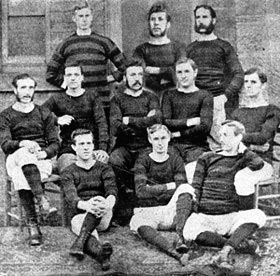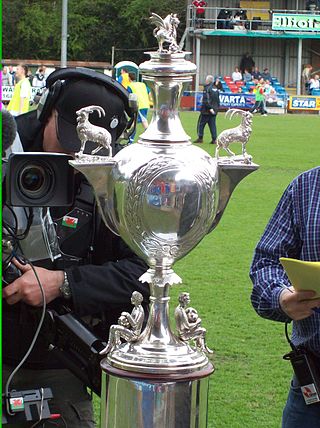Shropshire Wanderers F.C. was an amateur association football club based in Shrewsbury, England. The club was active during the 1870s and once reached the FA Cup semi-finals.
Wednesbury Strollers F.C. was an English football club based in Wednesbury, Staffordshire which was active in the 1870s and 1880s.

The 1877–78 Welsh Cup was the first season of the Welsh Cup. The cup was won by Wrexham who defeated Druids 1–0 in the final.
The 1878–79 Welsh Cup was the second season of the Welsh Cup. The cup was won by Newtown White Star who defeated Wrexham 1–0 in the final.
Clopton Allen Lloyd-Jones was an English businessman and amateur sportsman, best known for football and cricket. He played for the Clapham Rovers when they won the FA Cup in 1880 and was selected, but did not play, for Wales as an international.
The 1881–82 Football Association of Wales Challenge Cup was the fifth season of the competition.

The 1882–83 FAW Welsh Cup was the sixth edition of the annual knockout tournament for competitive football teams in Wales.
Southill Park F.C. was an English association football club, originally from Hampstead in London.
The Shropshire County Cricket League is a league cricket competition based in the county of Shropshire, England.
William Henry Fletcher was a Welsh Anglican priest in the first third of the 20th century who rose to become Archdeacon of Wrexham.
Wellington St George's F.C. was an English association football club from near Telford in Shropshire.
Shrewsbury F.C. was a football club based in Shrewsbury, England. The club is recorded as playing its home games at Monkmoor Lane, Shrewsbury.
All Saints F.C. was an association football club based in Shrewsbury, England.
Llanerchrugog F.C. was a football club based in Rhosllanerchrugog, Wales.
Shrewsbury Engineers F.C. was a football club based in Shrewsbury, England.
Newport Football Club was an association football club from Newport, Shropshire. In the 1880s the club was often referred to as Newport Town.
Newtown F.C. was an association football club from Newtown, Powys, active in the 1870s, and (indirectly) a progenitor club of the current Newtown club.
White Stars F.C., also known as White Star or Newtown White Stars, was an association football club from Newtown, Powys, active in the 1870s, and (indirectly) a progenitor club of the current Newtown club.

